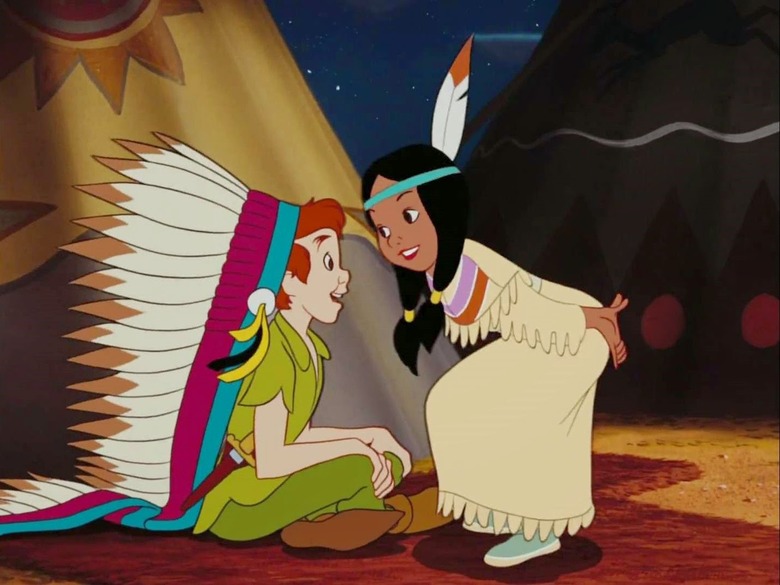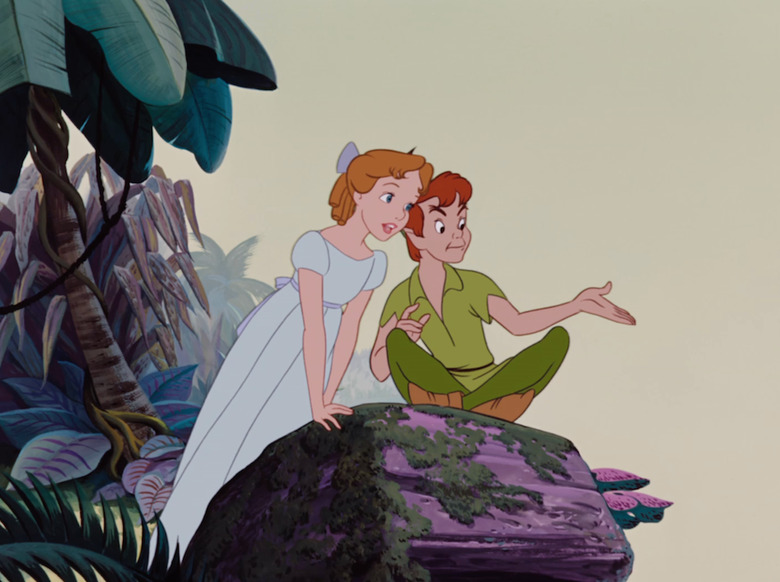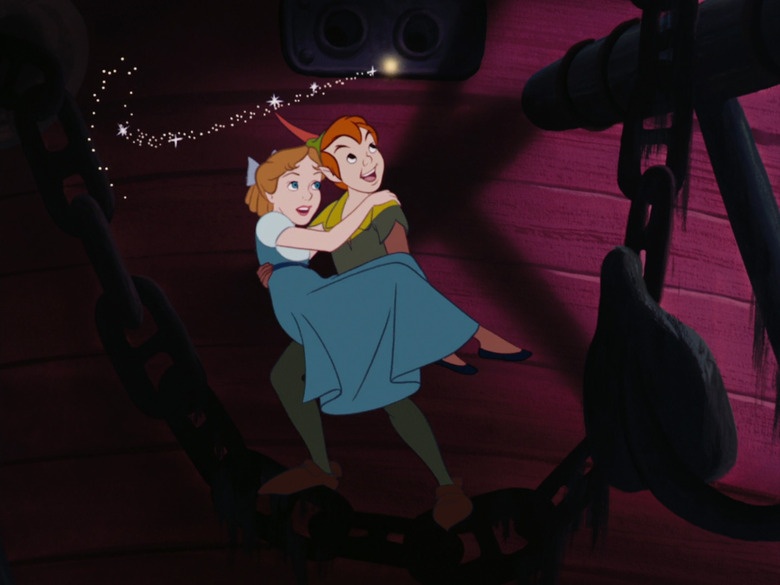Grappling With Disney's 'Peter Pan' On Its 65th Anniversary
(Welcome to The Disney Discourse, a recurring feature where Josh Spiegel discusses the latest in Disney news. He goes deep on everything from the animated classics to the theme parks to live-action franchises. In this edition: Peter Pan turns 65 and it's time to grapple with this popular but problematic classic.)
Few stories have endured throughout the last 100-plus years more than the tale of a boy who could fly and never had to grow up. Peter Pan, the Lost Boys, the upstanding Darling children, Captain Hook, Never Land, and the other details within the iconic yarn weaved by J.M. Barrie have, like pixie dust, lingered in films, TV specials, books, and the Broadway stage literally for generations. The 1904 play led to the 1911 novel, both of which inspired stage musicals, other plays, films and more that directly adapted or were heavily inspired by Barrie's work.
Today marks the 65th anniversary of arguably the most famous adaptation of Barrie's eternally young pirate, Disney's animated take on Peter Pan, a film marked as much by its memorable imagery and music as by its immensely troublesome, retrograde depiction of women and people of color.
The Striking and the Embarrassing
Peter Pan inspired one of the most popular theme-park attractions in Disney history, Peter Pan's Flight. Peter's fairy friend Tinker Bell is, next to Mickey Mouse, the most enduring symbol of the Walt Disney Company. The film itself, when you adjust for inflation, has raked in nearly half a billion dollars domestically over multiple theatrical releases. In some way, what makes the film work for so many people can be almost entirely separated from its troublesome, often wince-inducing aspects. We remember songs like "You Can Fly" and "The Second Star to the Right" just as quickly as we choose to forget that Peter Pan also features a song called "What Makes the Red Man Red." The nostalgia that serves as the underpinning for Peter Pan is sneaky that way; just as it lets you pretend you're a kid again and forget about being an adult, it gives you permission to ignore the elements of the story that are too challenging or embarrassing to consider.
Of course, Disney animation is no stranger to blending the striking and the retroactively embarrassing. Over the last quarter-century, Walt Disney Animation Studios has populated its films with more non-White characters, such as the leads of Aladdin, Mulan, The Princess and the Frog, and Moana. That period has offered many steps forward for the House of Mouse, steps beyond the days of "What Makes the Red Man Red," but it's also featured growing pains: Aladdin depicted Middle Eastern culture, but almost entirely whitewashed it with its too-modern-sounding and White cast; Pocahontas tried to paint a more accurate picture of Native American culture than, say, Peter Pan, but still grafted a fairy-tale romance onto the harsh cruelties of the English occupation of the New World.
Those mistakes, however, are at least reflective of a culture of filmmakers who wanted to improve themselves and represent diversity in a more respectful way. They are, perhaps, long-overdue baby steps, but when you consider the era of Peter Pan and other Disney animation of the 1940s and 1950s, the baby steps feel like leaps. A good number of early Disney films utilized non-White characters for easy, lazy jokes that traffic in stereotypes that are dated at best and painfully racist at worst. Some examples — such as the jocular group of crows in Dumbo, the infamous animated sequences in Song of the South, and Princess Tiger Lily and her Native American tribe in Peter Pan — are more notable. But there are moments that are easier to look past, from the dark and literally faceless roustabouts in Dumbo, to the Siamese cats in Lady and the Tramp and The Aristocats to King Louie and his comrades in The Jungle Book.
So, on one hand, if you watch Peter Pan as an adult for the umpteenth time, it's easy to be utterly repulsed by the depiction of Native Americans. (If you have not seen the "What Makes the Red Man Red" musical sequence recently or ever, just know that it somehow gets worse after that title.) The long-lasting popularity of Peter Pan does not excuse its racism; we can shrug it off, even if it shouldn't actually be shrugged off. The reasons to look past its racism are easy to spot. The movie was made 65 years ago. Its creators were almost entirely White men. Even more, they were adapting a story from the turn of the 20th century, one that does include Tiger Lily and her tribe (then dubbed "Piccaninny"). The racism present in the Disney film may be embarrassing, sure, but if it was there to begin with, who's truly at fault?
Some of those reasons can apply to the sexism inherent in Peter Pan, too. A film made in the early 1950s primarily by men, inspired by a story written just as the 20th century began, maybe shouldn't be expected to offer up a picture of strong, independent women. Whether or not such expectations are fair, though, does not eliminate the fact the way that Peter Pan does portray female characters like Wendy Darling and Tinker Bell is painfully regressive. Yes, the film is borne of pure fantasy — Wendy and her brothers encounter fairies, mermaids, and other fantastical creatures during the film. But even if imagery such as Wendy being attacked by jealous mermaids over Peter Pan's affection isn't grounded in reality, it's still imagery of three women fighting over a man who watches them.
If anything unites most of the female characters in Peter Pan, it's that desire to be number-one in the title character's heart. Peter, as voiced by Bobby Driscoll, is not quite at the age where a boy actively notices a girl and pursues her romantically. (The underrated 2003 live-action Peter Pan from Universal Pictures cast two teenagers as Peter and Wendy, and didn't shy away as much from the undertones of romance between the leads.) But Peter doesn't have to be aware of his apparent effect on the female characters of Never Land, because they're too busy duking it out to see if they can be his favorite. Peter is not as endearing as he could be, either; when the mermaids try to kill Wendy, he's too busy laughing at the melee to realize that his new friend from London might be in harm's way.
What is it, then, that compels people to return to Peter Pan?
A Broken Classic
The Disney film endures in spite of these painful elements, but other artists and studios have tried to retell the story over the years to mixed success. Here is a story whose problematic elements are all but impossible to ignore. The recent live-action retread Pan, co-starring Hugh Jackman, ran into trouble when Tiger Lily was played by the very talented, but very White Rooney Mara. No doubt, Pan could only be an improvement over the way that Tiger Lily has been portrayed in other versions of the story; Disney's take from 1953 is almost jaw-dropping in its lazy use of stereotypes, with the Native American characters being dubbed "Injuns," given literal red skin, and actually passing a peace pipe around a fire. But it doesn't excuse the whitewashed casting; studios arguably should be now more aware of the negative optics of such a choice.
Newer versions or retellings of J.M. Barrie's story either ignore some of the icky racial and gender-based elements altogether, or only acknowledge them in passing. Steven Spielberg's Hook doesn't feature a new take on Tiger Lily, and when the film begins, Peter is already married with children so even though Tinker Bell is still besotted with him, she's not murderously jealous. The 2003 film barely features Tiger Lily, and the romance between Peter and Wendy is more heightened, such that this time around, Tinker Bell has a good reason to be envious, though it's much more ineffectual. In some respects, to watch the newer versions of this story are to watch filmmakers correcting the old course in real time.
It is, then, kind of a shame to consider the whole of Disney's Peter Pan as it turns 65. The film can be quite beautiful in its depiction of Never Land, or of the Darling children soaring in flight over the nighttime skies of London. Captain Hook, as brought boisterously to life with an effusive voice performance by Hans Conried, is always going to be one of the most best villains in Disney history. Unlike a lot of the 1940s-era package films and even Alice in Wonderland, there's a full-throated coherency to the story here. Some of the parts of Peter Pan stand out for good, even after six and a half decades.
It is, perhaps, more convenient to pretend that the other parts of the film don't exist, or that those parts which are nothing short of embarrassing can just be rewritten. We think of Tinker Bell now as either the lead of a series of direct-to-DVD features or as the flittering fairy who will soar onto the screen for a second or two to sprinkle pixie dust. Tiger Lily and her Native American brethren barely make a cameo appearance in Peter Pan's Flight at the theme parks, and are otherwise absent from Disney media. It's probably for the better, but also suggests a kind of shame that the studio feels towards the film. Marc Davis, one of the film's animators, and one of Disney's vaunted Nine Old Men of animation, once acknowledged that if he and his colleagues could make the movie again at a later time, they wouldn't have even included the Native American characters.
All This Has Happened Before...
Peter Pan was not the first male-centric Disney animated film, coming years after the studio's best film, Pinocchio. In the intervening 65 years, the studio has made some other monstrously successful (artistically and commercially) male-centric animated films, from The Jungle Book to The Lion King and Big Hero 6. Many of those films, much like Peter Pan, are meant to be adventure yarns to tap into the imaginations of boys young and old. Travel back to the jungles of India to face off against tigers and snakes and orangutans. Survive a life in the Serengeti and then become king of all you can survey. Become a superhero. Fly to a land where you can never grow old and you can always play at being a pirate. These films focus more on that adventure than on what surrounds it, hoping that the audience will too.
The childlike tendencies of Peter Pan are a core facet of Disney animation, even if the filmmakers weren't quite as able to handle the balance between the male and female leads of the film. For good or ill, Peter Pan is really the first Disney animated feature to not solely be about a male or a female character, in spite of its title. Wendy Darling is as much a main character as Peter himself is, and while they are both better developed than, say, Snow White or Cinderella and their respective princes, the emotional development of the characters can't hope to live up to that of future Disney animation. Disney had come a long way from the days when their princesses would pine after men who didn't have the luxury of first names. But Peter Pan suggests that they still had a long way to go.
"All this has happened before, and it will all happen again." This line opens Peter Pan, a portent that's both inviting and mildly depressing. Nostalgia is the backbone of the Walt Disney Company, its allure enough to make people come in droves to pay and see live-action remakes of animated films like The Jungle Book, Alice in Wonderland, and Beauty and the Beast. Nostalgia is what draws people to the theme parks, and to watch the same movies again and again and again. Nostalgia is what draws people to the promise of a place like Never Land. And it's what draws people to look past the flaws of a movie like this, when it taps into something almost primal, the sensory appeal of becoming a child again and not having to worry about anything but happy thoughts and a shadow that won't stay still.



